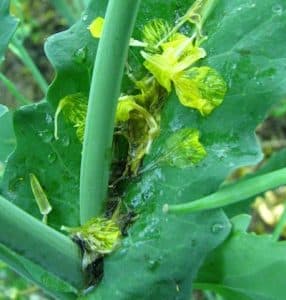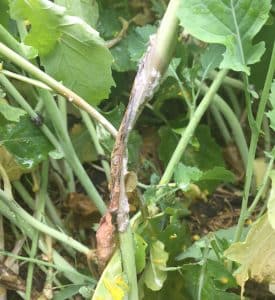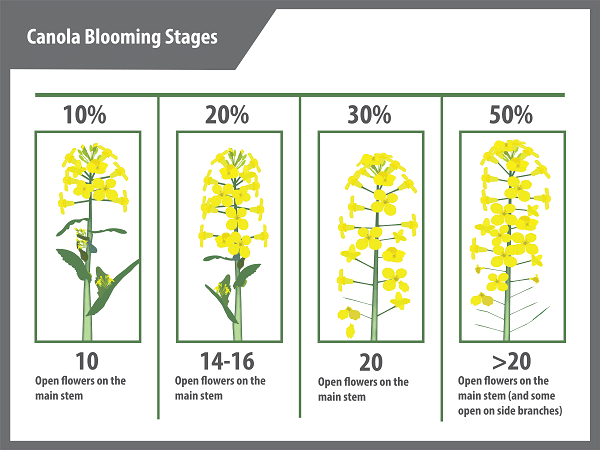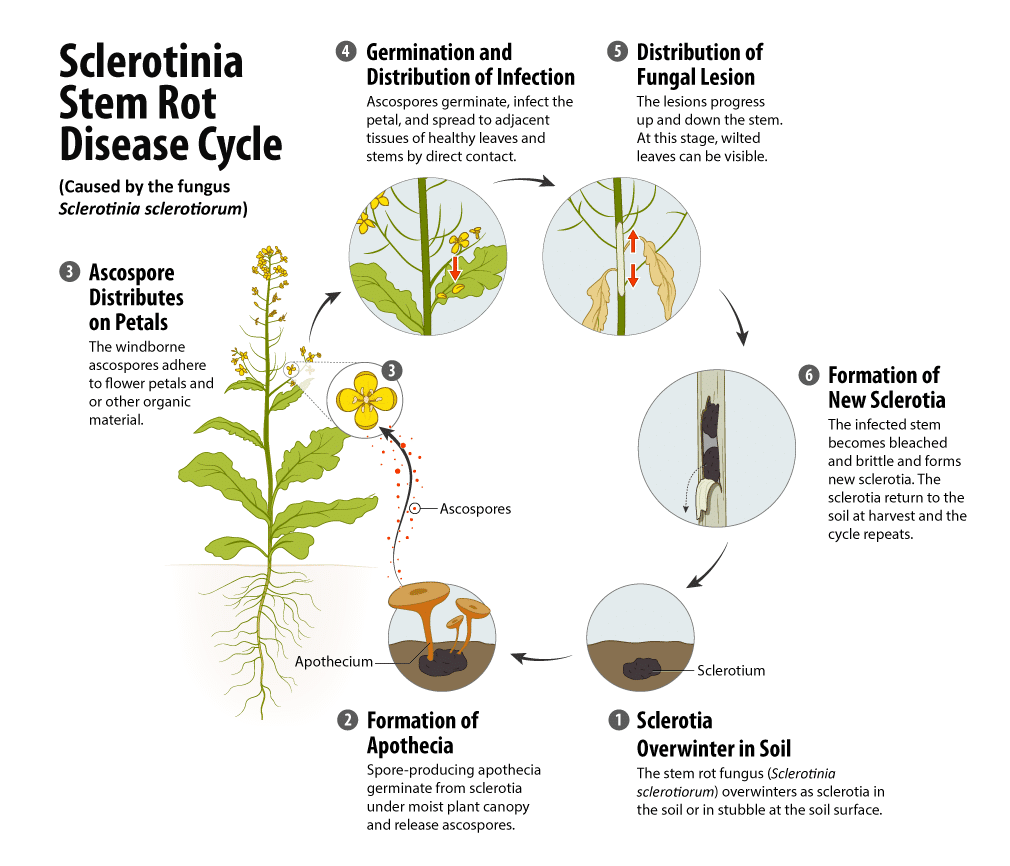Use the Sclerotinia Risk Assessment Tool to help with decisions.
The decision to spray fungicide to prevent sclerotinia stem rot may hinge on answers to these four questions…
- Were environmental conditions prior to flowering wet enough for apothecia development and survival?
- Is the canola crop canopy dense and is yield potential high?
- Does the weather forecast predict precipitation and/or humidity during the flowering period?
- Is the pathogen present in sufficient quantities?
If the answer is “yes” to all four questions above, then spray. If the answer to some of the questions is “no”, then the decision is more difficult. This article explores these concepts in more detail. (For more on sclerotinia stem rot identification and management, please see the Canola Encyclopedia.)
When considering fungicide cost ($20-$30 per acre, including application), a fungicide would have to preserve one to two bu./ac. of yield to break even (based on $15 per bushel canola prices).
High yield fields with moisture will often surpass this economic threshold. Yield loss is roughly half of the “incidence rate,” which is the percentage of plants infected. If disease infects 10 per cent of plants, yield loss will be five per cent.
It is too late to spray after symptoms have appeared on the plant, so the decision has to be based on the risk situation before and during the spray window – which is 20 to 50 per cent flower – and the forecast of weather and yield to come.
Moisture is key
Moisture is the big risk factor
Host and pathogen – the two other disease triangle requirements – are already well established. Sclerotia just need moisture to germinate and release ascospores. Moisture during flowering will enable ascospores to infect canola petals and grow into leaf and stem tissues when the infected petals fall into the crop canopy. And moisture during and immediately after flowering will promote infection that can lead to an economic loss of yield.
How much moisture is enough?

If the soil surface underneath the canola canopy remains wet for most or all of the day, this promotes germination of sclerotia and production of apothecia, the tiny mushrooms that release sclerotinia spores. AAFC plant pathologist Kelly Turkington, in a study completed in 2023, concluded that relative humidity (RH) of 80 per cent or higher for at least 21 hours per day will elevate the disease risk. A few hours per day with lower RH seems to be enough to disrupt infection. Humid conditions in the canopy will promote petals sticking to plants, and provide the moisture needed for infection. (Without moisture after petal drop, things dry up and the risk is reduced.)
Relative humidity is a good indicator of ample moisture
If local weather charts show that RH is staying above 80 per cent for long stretches in June and July, this is a good indicator of favourable moisture conditions. If you have a series of days where the RH is going to be 80 per cent or more, especially during the day, then the conditions are likely to be favourable for infection. Note that RH levels will typically be higher in the canopy. If you walk through the canopy in early afternoon and your pants get wet, the field has favourable conditions for infection. (We call this the “wet pants test”.)
Other factors that INCREASE risk
Spores have to be present for infection
Apothecia are a sign that spores will be present. However apothecia are not always easy to find or distinguish from other mushroom-like fungal bodies that may be present. Other options for spore detection are petal tests and new tools, like the Spornado (20/20 Seed Labs) or DNA-based petal testing kits (Quantum Genetix and Discovery Seed Labs).
Higher yield situations
This increases the chance that disease pressure will be high, which increases the return on investment for a fungicide spray. With modern hybrids and higher overall yield potential of canola, the return on investment for a fungicide application depends more on conditions favourable for disease than on yield potential. Basically, if moisture conditions and spore counts are favourable for disease, yield will also be sufficient to make the fungicide pay.
Temperature
The pathogen prefers temperatures in the range of 10°C to 25°C. Moderate average temperatures in that range and moderate rainfall that favour host infection while extending the bloom period and reducing sloughing off of leaves will maintain potential infection sites.
Farm history of disease
Is there a history of significant levels of sclerotinia in the specific field or in adjacent fields? Host crops include canola, soybeans, sunflowers, potatoes and pulses. In most canola growing regions, there is a history of significant sclerotinia.
Petals sticking
Extensive sticking/clumping of petals in the crop canopy especially in the leaf axils and bases.
Factors that DECREASE risk

- Dry conditions through the flowering period. If the environment and the canopy is dry during this period, then ascospore release is reduced minimizing the amount of infected petals and further spread infection.
- A poor canola canopy that allows for a lot of air flow. When doing the wet pants test, if the canopy and your pants and boots are dry at 8-10 a.m., then the field has less favourable conditions for the disease.
- Below- or above-average temperatures (less than 10°C or greater than 25-30°C) and limited rainfall. Risk is limited when current conditions are dry, max daily temps are 30°C or more, and this is forecast to continue for seven to 14 days. Will hot dry weather stop sclerotinia?
- A large rainfall event over one to two days that is followed by several days or one or two weeks of dry, warm conditions.
- Continuous rain events that may lead to washing off of petals from plants and remove spores from the air, while trapping spores in water droplets that form on the tops of the apothecia. Note however that rain events that actually reduce sclerotinia stem rot risk would be unusual. It could take three weeks of saturated soils to kill the sclerotia resting bodies in the soil. As Kelly Turkington says, “If flooding occurred for three weeks, sclerotinia would likely be the least of your worries.”
- Grow a cultivar with some level of sclerotinia tolerance. There are a few out there.
If the potential for disease is uncertain…
- Apply the lowest rate of fungicide. Use programs or lowest-cost products to keep costs as low as possible.
- Always use highest label water rates to get the most coverage and best efficacy.
- Wait. Applications near the end of the spray window can be an effective time to spray, especially in a situation where moisture changed dramatically for the good.
- Consider an ‘on-off’ or zone-spraying approach to fungicide application, basing it on previous yield maps or current NDVI maps. Fungicide application could be turned ‘on’ for areas with high yield potential and ‘off’ for typically low yielding areas.
- If you need to spray so you can sleep at night, then spray. But leave a few test strips to compare disease amounts and yield. This can help with future decisions.

Spraying in hot weather
Fungicide labels do not have temperature restrictions. Fungicide companies will say to avoid spraying in temperatures over 27°C or 28°C. On hot days, the best time to spray is in the morning or evening, before or after the temperature peaks. However, it often comes down to when the aerial applicator can squeeze in the job. When risk assessment indicates a need to spray, timely application with reduced efficacy is better than late-window (or no) application.
Heat presents three risk factors for fungicide performance:
- Hot weather can result in rapid plant growth and a thin cuticle. This can lead to potential crop burning from the spray.
- Oil-based adjuvants can increase heat damage to petals, causing them to abort.
- Rapid vaporization of spray droplets can reduce coverage.
Delta T. The temperature recommendation is related to Delta T, or “wet bulb depression,” which accounts for the evaporative potential of the air. On a hot summer day, Delta T can be high enough to evaporate spray droplets before they can spread over the target area and provide maximum protection. This can be an issue for fungicides. “We want the droplets to stay liquid as long as possible,” says sprayer specialist Tom Wolf, who wrote this article about Delta T.
Second applications
Early infections cause more yield loss than later infections, and the economic benefit of a fungicide application is generally higher with early applications. Kelly Turkington says studies by Morrall et al. (1985, 1989) and Rude (1989) have demonstrated that effective control is possible when disease-favourable environmental conditions do not occur until full bloom. If conditions are favourable throughout the risk period, Rude found that the extent of infection and the potential for yield losses were significantly higher when canola plants were infected at early bloom than at late bloom. Thus, yield increases achieved by fungicide application at late bloom may not be high enough to provide economic control.
Second applications can pay off if:
- Variable crop staging extends the flowering period. If conditions are favourable for disease, a crop at variable stages adds some complication to the timing decision. Variable stages mean a longer flowering period across the field and an increased challenge to time the fungicide application. Are plants at later stages healthier and more plentiful? If yes, timing an application to protect those plants might be the better move. If difficult to tell which stages will contribute most to yield, a split application may be preferred.
- Thin stands with late branches extend the flowering period.
- Continued rain throughout flowering encourages late-season infection. Given the environmental conditions, late season infections don’t typically contribute as much to yield loss but an application will help reduce inoculum-going back to the field.
- Flowering results after a hail setback.
More…
- Sclerotinia stem rot chapter in the Canola Encyclopedia
- Canola Watch library of sclerotinia stem rot articles
- Country Guide article: How to keep sclerotinia infection to less than 5%
- Fungicides available for sclerotinia stem rot
- Managing Sclerotinia in Oilseed and Pulse Crops. Prairie Soils and Crops 4:105-113 (by Turkington, T.K, Kutcher, H.R., McLaren, D. and Rashid, K.Y.)



